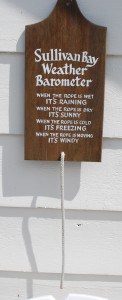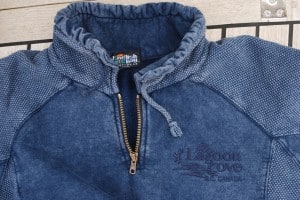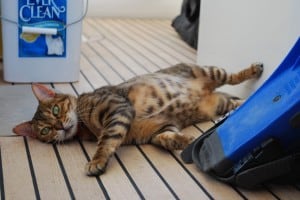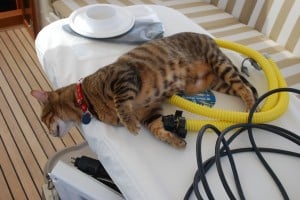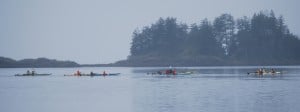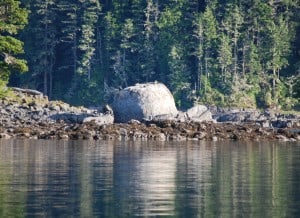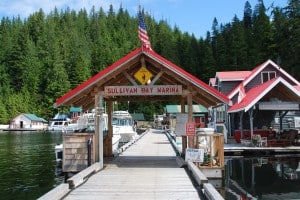
The “official” entrance to Sullivan Bay Resort – actually, it’s the covered fish cleaning station halfway out the dock from the cluster of buildings that make up the resort. This is the infamous (at least to us) fish cleaning station where Kap took her nocturnal dip in the frigid waters one night while we helped the Couverden gang clean their crabs. Kap accidentally stepped into a gap between the fish cleaning station float and the main dock float – and down she went! Next morning when word got around what happened, the resort owners immediately tightened up the chains holding the floats together, and now they’ve completely rebuilt the floats in the past couple of years to make one seamless float.
As I start writing this, it’s July 19th and we’re at Sullivan Bay Resort, near the top end of the Broughton Archipelago, on the north side of Broughton Island.
When it rains, it pours. First it was the generator shutdown with the clogged sea strainer – which miraculously cleared itself. Then on the way into Sullivan Bay the watermaker conked out, with an error message to check the pre-filters. One pre-filter was pretty dirty, and the other was so-so, but we replaced both anyway. Fresh drinking water isn’t something we want to take chances with.
The water maker was supposed to have been serviced over the winter, but when I checked the maintenance invoice for the finished work, it didn’t show up. With all that we had going on, I didn’t cross-check our wish list against the actual work, and now I think we’re paying for it.
After swapping out both pre-filters, the watermaker still quit after running just a few minutes – but now it indicated a pressure problem within the unit. After fiddling for quite some time Kap gave up, and we knew we needed professional assistance. I did a Google query on Sea Recovery watermakers, then searched their site for tech support in B.C. – and was astonished that it listed Brian Coverely at Delta Marine in Sidney. We know Brian pretty well, as he works half-time for Fleming Yachts as their North American warranty rep. We’ve had him do work for us on Flying Colours several times in Sidney.
It was now early evening, but using our satellite phone, I called Brian on his cell number and he answered immediately (there’s no cell phone coverage at Sullivan Bay, and that makes the satellite phone one of the best electronic gizmos on the boat). He’s an Aussie from Perth, but has worked in Sidney for quite a few years – and he’s a good guy! After explaining the problem, what we’d done so far to clear it, and giving him the error messages, Brian surmised we probably had a pump failure – and if so, he’d have to order one from the company’s Southern California warehouse the next day. He gave us a few other things to try, and we agreed to get in touch the next morning.
That night, we decided to eat off the boat – as the Sullivan Bay Resort restaurant was featuring a “custom cut” rib eye steak night. It was a welcome treat, but frankly, the prime NY strips and tenderloin steaks from our Bellevue QFC that I have in our freezer on board Flying Colours are much better on our BBQ. The next night was Greek night, and I have to admit it was better than any Greek dish I know how to make. For our third night, I fixed pork schnitzel on the boat – and Kap says it’s the best.
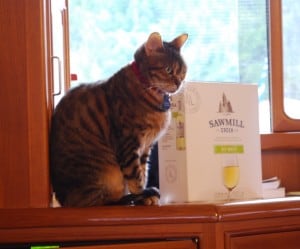
ZuZu says she’s partial to the B.C. Sawmill Creek Sauvignon Blanc that we found at the Sullivan Bay General Store. The box wine here in B.C. isn’t bad, and while we favor the high-end B.C. reds for dinner wine, these whites are very good for warm summer Happy Hour afternoons.
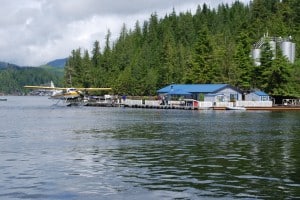
Sullivan Bay Resort is one of the many stops for Kenmore Air in the Broughton’s – that is, if they have a passenger for it. This float is officially called the Sullivan Bay International Airport – after all, Kenmore Air is a U.S. airline). The blue-roofed home is a private residence. At the very left of the photo is the 18th hole of the Sullivan Bay Golf course.
Next day, after our further attempts to get the watermaker running had failed, we spoke with Brian again on the satellite phone, and it was agreed that we should meet at the end of the week in Port McNeill. In the meantime, Brian would order up a pump (gulp . . . at $1,500).
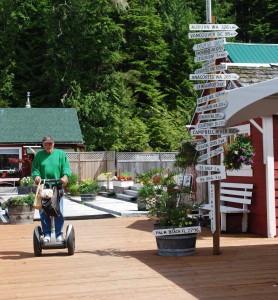
The resort info sheet mentions that if you walk from the tip of the fuel dock, past the resort buildings, and then out and back on all four guest boat finger docks, it’s 1 1/3rd mile – so those who want exercise can be seen walking this multiple times a day. We were amused to see this old guy on his Segue, presumably getting his “exercise” by riding it multiple times along the exercise run. Go figure! Note halfway up the milepost sign that it's 265 miles to Anacortes.
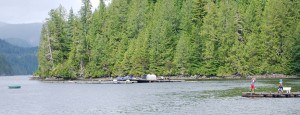
A golfer (at the far right) tees off on the 18th hole (or is it the 1st?) of the Sullivan Bay Resort golf course. The "hole" is in the satellite TV antenna floating on the water at the photo’s left edge. If you hit the hole, your moorage for the night is free.
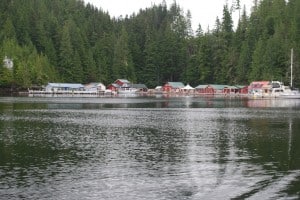
Sullivan Bay as we pulled away, bound for Port McNeill and the watermaker repair. This resort is all on floats, with no shore access, and it has more float buildings than anywhere around modern Broughton Archipelago – a hundred years ago, this would have been a small encampment.
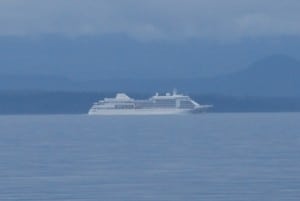
Shortly after we exited Wells Passage and entered the east side of Queen Charlotte Strait we spied a cruise ship way off in the distance, undoubtedly from Seattle and headed for SE Alaska. Ten or fifteen minutes later the swells from the ship’s wake reached us – they’re good sized.
We lounged around Sullivan Bay for two more days, conserving water as much as we could, determined not to fill our tanks from the dock fresh water hoses. The fresh water here is tapped from a stream on shore that probably empties from a lake in the hills above the bay. It’s brown in color, like weak tea, and is called “cedar water” from the coloring that it picks up from the cedar forests it flows through. The water is somewhat safe to drink – but only after boiling it for two minutes. Last year while at Sullivan Bay, Raz came down with giardia just a little while after Kap washed down the boat decks with dock water – and we figure she got it from licking her feet afterwards.
After cruising down the 10 (or so) miles of Wells Passage, we entered Queen Charlotte Strait – another 10 miles of water that we have to cross to reach Port McNeill on Vancouver Island. It was flat calm . . . what a day this would have been to head north across Queen Charlotte Sound – which is open water to the Pacific Ocean – to spend a few days in Shearwater. We wish we could, but the watermaker has to get fixed.
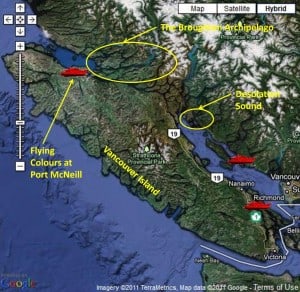
This Google Map image is taken from the Fleming Owner’s web site (www.flemingowners.org), where the current position of all participating Fleming yachts around the world can be posted via Lat/Lon coordinates. Flying Colours is in the upper left, at Port McNeill Fuel Dock Marina. The location is near the top end of Vancouver Island – about 200 miles (as the crow flies) from Seattle. There are two other Fleming yachts on the map, one located in Secret Cove, B.C. (on the Sunshine Coast above Vancouver), and the other on Thetis Island (in the Canadian Gulf Islands, and shown just beneath the name Richmond on the map).
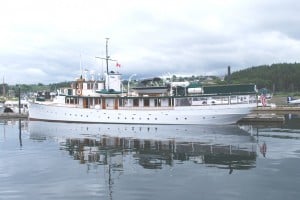
Compared to the singularly gauche appearance of the cruise ships, the elegant Thea Foss fantail yacht across the dock from us at the Port McNeill Fuel Dock Marina was a welcome sight. This is one magnificent yacht, and we could look at her all day long – but sure wouldn’t want the maintenance that’s necessary to keep her going. She’s named after the founder of Foss Tugs, Thea Foss, who was also the inspiration character for the movie Tugboat Annie. She's the private cruising yacht for the extended Foss family out of Seattle. She was built in 1930 for John Barrymore Sr, and after serving as a subscripted naval vessel for patrol duty during WWII, the Foss family bought her in 1950 and turned her back into a classic cruising yacht. She's 120' long, with a 21' beam.
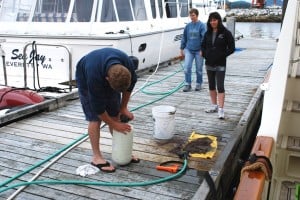
Brian dumped the sand from the “media” filter onto a towel on the dock, then repacked it. That solved our watermaker problem.
The next morning, Brian Coverely, our tech guy for Fleming Yachts from Delta Marine down in Sidney, as well as the tech specialist for Sea Recovery watermakers, arrived right on time at 10AM. He’d driven up from Sidney – about five hours by car – arriving with his longtime SO, Val. He jumped right into the lazarette to look over the watermaker situation, and within a half hour had narrowed the problem down to the “media” filter, and not the pump (yeah! A pump on the fritz would have cost us $1,500). This filter is sand-filled, and as soon as Brian bypassed it the watermaker worked. He removed the media filter, took it out to the dock and emptied it onto a towel. He then repacked about half the sand back in, closed it up, re-installed it, and declared the watermaker fixed.
The forecast for the next two days called for gale force winds in Johnstone Strait, so we decided to wait it out in Port McNeill. We had a ring-side moorage spot at the marina, where we could watch all the boats arriving and departing, and just taking it easy wasn’t an unpleasant assignment.
Boy, talk about effective product placement! My standard summer cruising “uniform” is shorts (I don’t wear long pants – ever! – if I can help it while on Flying Colours), Teva sandals (but I go barefoot 95% of the time, and only put them on when I don’t want to get my toes banged up or filled with dock slivers), a ratty old Mainstar polo shirt . . . and since the weather is often cool on the water, a well-worn logo sweatshirt from Lagoon Cove. Invariably, when I’m off the boat in my uniform, someone will comment on Lagoon Cove – that they visited there in 20-aught-x, or mention how much they enjoyed the prawn Happy Hour and Bill’s bear stories, or whatever. Almost every resort or marina we stop at has logo clothing for their place, and I’m usually sucker enough to buy it, but none of it compares to the comments and conversations I get from the Lagoon Cove sweatshirt. And interestingly, it’s so subdued that I’m surprised anyone can even read it from 5’ away, but they always seem to. It says a lot for good product placement.
I mention all this because one day I was leaving the IGA grocery in Port McNeil, and as I walked past the front of a Jeep Cherokee a guy hollered out, “Hey, where’d you get that sweatshirt?” I walked over, told him Lagoon Cove Resort, and his response was, “Yeah, my wife and I used to work there . . . ya-da-ya-da-ya-da.” Amazing how often that happens!
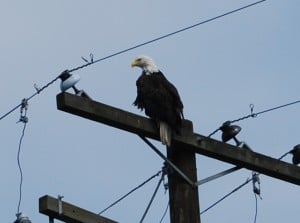
The Port McNeill dock eagle, just waiting for another fisherman to fillet his catch at the fish cleaning station on the dock – and he’ll then swoop down to snatch any entrails thrown into the water.
Kap made her usual twice-per-day visit to a hardware or marine store yesterday afternoon in Port McNeill (she grew up visiting Army/Navy Surplus stores, and this has replaced her focus). On the return to the marina, she spotted a huge bald eagle on the dock, patiently sitting there while a fisherman gutted a fresh-caught salmon at the dock’s fish cleaning station – hoping for a morsel that might be thrown in the water. He’s apparently a local who isn’t afraid of people, as she got within 3’ of him, and figures she could have quietly walked right by him without disturbing him, but she met another person there and it was one too many people for the eagle’s sense of safety.
Later in the afternoon, Kap made her second visit to the marine store, and when she got to the head of the dock she called me on her cell phone to say that the eagle was still there, but perched on a power pole, waiting for the next caught fish to be brought in. I headed up with my camera, and sure enough, this guy wasn’t going to be bothered by anyone, and with lots of noise around he/she just sat there looking around. His feathers were a bit scruffy, so maybe he’s too big, or too old, to catch dinner on its own, or maybe he’s just learned that scavenging from the fishermen on the dock is an easier way to catch salmon.
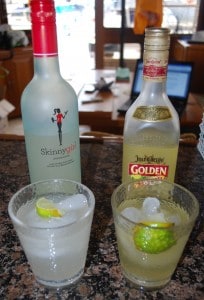
One of our more more serious cruising duties is checking out the best in Happy Hour libations. In B.C. they sell a pre-mixed margarita called Skinny Girl, a lower calorie version that’s made with Agave Nectar for sweetener and Blue Agave Tequila for potency. I still prefer the old (and easy) standby, Jose Cuervo Golden Margarita, but Kap now prefers a 50-50 mixture. I also make my own margaritas from scratch - and they're pretty good - but they're also a lot of work, and sometimes I just feel like quick and easy.
Sunday morning – a good day and time to have a cooked breakfast in town. We left Flying Colours before anyone else on the dock was up and around, and the fuel dock hadn’t yet opened. We were headed for a good café in town – Bo Banee’s – that serves quite good food, including awesome Mexican food for lunch.
When we got to the head of the dock, there was a terrible garbage mess in front of the two dumpsters kept there for boaters who are unloading trash from their boats. At night, the dumpster lids are chained shut – but not very tightly – and a bag of garbage from one dumpster had been pulled out. It could only have been by a bear in the night, as the crows and ravens who hang around most likely couldn’t have pulled that feat off. Besides, the garbage was trounced on, and that was almost certainly from the bear. It’s a really good reason why it isn’t wise to go for late evening walks off the docks.
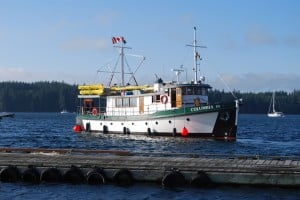
Columbia III – “The Columbia III was designed in 1955 by renowned naval architect Robert Allan of Vancouver B.C. She was built the following year at Star Shipyards in New Westminster B.C. and still has her original Gardner diesel engine. She serviced the coast as a hospital ship, answering emergency calls until 1968, when it became evident that float planes met the needs of the logging camps and coastal villages much faster than a ship traveling at 8 knots. Also, the coastal population was dwindling as people left the hardships of isolated living and moved to urban areas. The Columbia III was restored to its present immaculate condition in 1990 by Bill McKechnie of Victoria B.C. and since then she's been used as a charter boat, especially as a kayaking "mothership". Today still, wherever we go, she is welcomed and recognized, and many stop to reminisce, relive and share their personal experiences aboard the Columbia III.” (Text taken from the Mothership Adventures website.)
We frequently share the dock at the Fuel Dock Marina with a great-looking old boat called the Columbia III. She usually arrives while we’re there, disgorges a half-dozen people, and the crew then spends the next couple of days doing a yeoman’s job of swabbing her decks, offloading stateroom bedding for washing, and re-provisioning. She’s a charter vessel, owned by a local family in Port McNeill, and they run a very highly respected company called Mothership Adventures (www.mothershipadventures.com). They carry 8 kayaks on the upper deck, and during 4-7 day charter cruises their guests (who pay upwards of $1,500-$2,500 for the all-inclusive passage) explore the many bays throughout the Broughton’s. It must be popular, as they always seem to have a full complement of guests when they depart. Their website has complete information on schedule and price.
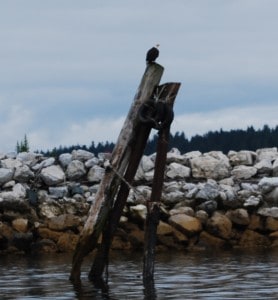
As we departed the Fuel Dock Marina, I was busy on Flying Colours’ deck getting the fenders and lines ship-shape. I looked over at a piling next to the new breakwater being built and who should I see but our friend, the fish mooching Eagle, sitting atop the piling.
Finally it was time to leave Port McNeill, to see if we could find a quiet anchorage to spend the week or so before returning to catch our flight home. We didn’t want to go far into the Broughton’s, as that’s just a waste of diesel and cruising time going back and forth. We settled on Farewell Harbour, where we had anchored two years ago while waiting for a mail shipment from Alison to come into Port McNeill. We really liked it, and while it isn’t the most protected harbor, particularly from northwesterlies (which Johnstone Strait is noted for), we figured we could find a good spot there. We set our sights for departure on Monday, July 25th. Our return date to Port McNeill for our flight is the 30th, so this gives us plenty of time to just hang out.
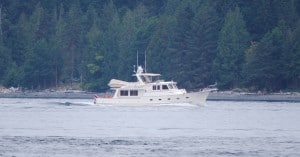
A few minutes after leaving Port McNeill we spotted a boat in the distance behind us – and with binoculars it was unmistakably a Fleming. It was the Tiger Lily, owned by Larry and Joan Achtemichuk of West Vancouver. Larry is an artist from West Van, painting watercolor on canvas outdoor scenes. They’re already on their way home from SE Alaska. As they passed us on Johnstone Strait I snapped this photo.
With current in Johnstone Strait, Kap figured a 9AM departure gave us our best cruise time. The night before, the wind was howling at the dock, but in the morning it was calm, cool, and the sky was solid overcast. We slipped the dock lines a few minutes early and headed out. The seas were calm, and our short cruise time was just a bit over two hours.
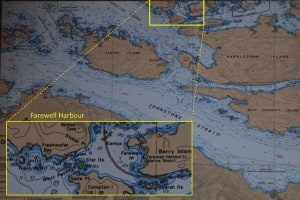
Farewell Harbour was named by the crew of the Beaver, a steamer belonging to the Hudson’s Bay Company that was used as a survey ship. This was the last area they surveyed so they named the harbor Farewell as they were through with their mission. Our cruising guide lists it as an excellent anchorage, with room for at least three dozen boats at anchor, in 30-50’ of water, and a mud bottom. We anchored at the “w” in Farewell on the inset blow-up of the harbor. Our entry from Johnstone Strait was through the West Passage, weaving through the rocks and around the north side of the Star Islets. This is at the very north end of Johnstone Strait, and turns into Queen Charlotte Strait a bit north of here. North of that is the open water of the Pacific Ocean at Queen Charlotte Sound and above the north end of Vancouver Island.
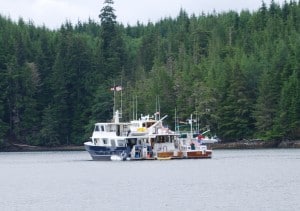
At first glance, it almost looks like a junk heap floating on the water, but it’s actually three pretty decent-looking cruisers rafted together and at anchor. They were just inside the entrance to Farewell Harbour.
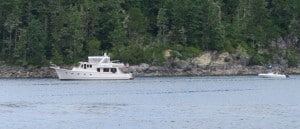
Just as we arrived at our anchorage in Farewell Harbour, the Fleming Devonsea pulled up anchor and departed. Was it something we said? Actually, we knew they’ve been over here for upwards of a week now, and that’s about as long as anyone stays in one spot.
Some of life’s more embarrassing moments can also be an “I learned from that” type of experience. Our first anchoring in Farewell Harbour was deemed too close to shore, as high north-westerly winds were predicted, and if we drug our anchor we could end up on the shore. As Kap slowly motored us forward on the anchor chain, I was at the bow bringing the anchor up using the handheld remote control for the windlass. As the anchor reached the surface, the line for the anchor sentinel buoy (which is tied to the attachment ring on the anchor) is now on the water’s surface and the buoy drifted back along the side of the boat. I was watching it, but didn’t figure it was a problem since I thought the line was only 40’ long – and therefore, wouldn’t extend as far aft as our now-turning props.
All of a sudden, as I looked over the bow at the anchor, I saw the anchor being jerked rearward towards the pointiest part of the bow and above the waterline. In a split-second we felt a shudder throughout the boat, the sentinel buoy line snapped loose, and the anchor started swaying wildly at the waterline. A moment later, Kap popped her head out of the pilot house door and hollered at me, “we’ve got a problem with the port engine – it’s just died!”
It was obvious – somehow the sentinel buoy line did reach far enough aft and had reached either the spinning prop shaft or the prop itself (turns out, unknown – or forgotten – by me Kap had lengthened the line to 50’, and that was long enough to reach the prop shaft where it exits through the hull).
With just the starboard engine running, we maneuvered to the new spot we wanted to anchor at and got it securely anchored. After setting the snubber on it, we then made an attempt to survey whatever had happened. Looking under the swim step at the stern, we could see A-oh’s little white head floating beneath the surface behind the port-side prop. That confirmed it.
But, now what to do? When a polypropylene line gets wrapped around a shaft, it happens so quickly and with such force that it typically melts the synthetic line onto whatever it’s wrapped around – and pulling on it will rarely free it. It has to be cut away, and that means someone has to get in the water, under the boat, with a knife . . . ah, yes, I’m sure you get the picture. The water temperature here is a frigid 50°F (or so), and unless you have scuba gear the task isn’t very easy.
Nevertheless, Kap said she was game to give it a try. She typically carries some diving gear on the boat – mask, snorkel, fins, and her wet suit – but not a BC (buoyancy control vest), regulator, or scuba tanks. This trip, too, she’d left her full wet suit behind and just brought her warm water “shortie” suit that’s short-sleeved, ends at the knees, and only 2mm thick. Whether she could even stay in the water enough to get wet was problematic, let alone working under the boat on gulped lung-fuls of air, popping up and back down every half-minute or so.
She got suited up, and we set up every safety idea we could think of, and she then slipped into the water off the swim step ladder. It was obvious that her fins were going to be too unworkable, and in just getting them off her feet in the water, her body temperature had cooled down to the point that she knew she couldn’t do the job. She climbed out – and I was glad, because I wasn’t in favor of it in the first place – we got a warm towel around her, and she took a very warm water shower to stop shivering.
In the meantime, I called the Fuel Dock Marina at Port McNeill – which we had just left three hours earlier – and asked them if they could locate a diver in the area and have him call us (luckily, we had both cell phone coverage and Verizon broadband Internet coverage here in the harbor). Within an hour my cell phone rang and it was Steve Lacasse from Sun Fun Divers in Port McNeill. He instantly understood, and while he couldn’t come out that afternoon due to a dive class he was scheduled to teach that afternoon, he could be there in his fast boat at 9AM the following morning. I didn’t even ask the price, as it wasn’t something we could not do, and whatever he charged was what we’d have to pay.
Next morning, we turned our VHF radio on just before 9AM, and a bit later we heard a transmission on Channel 16, “Flying Colours, this is Sun Fun Divers”. We connected up on Channel 69, and directed him to us (by now there were a couple other boats at anchor in the harbor). He pulled alongside, and immediately after we got him secured to our side deck, Steve quickly suited up in a dry suit (smart guy, given the water temperature), and knife in hand he jumped in. Within minutes he came up with two pieces of polypropylene rope in his hand, with A-oh on the end of one–and our poor little anthropomorphized buoy-guy looking a bit worse for wear, with some permanent bumps on top from his high-speed rotations around the prop shaft. Parts of the line connected to A-oh were blackened from being melted at the high friction heat.
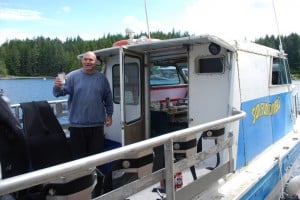
Steve from Fun Sun Divers with a latte that I made for him after his dive to cut out the buoy sentinel line wrapped around our prop. Steve runs a dive shop in Port McNeill, and we now have another friend whenever we drop in there.
While Steve was under the boat, I whipped up a latte for him once he got back aboard his boat, and we then chewed the fat for an hour before he headed back to Port McNeill. With a nice tip for his trouble, the $500 cost was a good lesson. It would also have paid half of the cost of a portable emergency scuba system that we almost bought at the Seattle Boat Show this past winter, and Kap has also vowed to get fitted for a dry suit as soon as we get home.
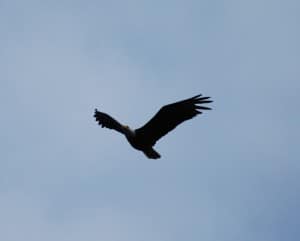
Oh, oh! Time to keep a close eye on ZuZu when she’s outside on deck. This bald eagle circled over us for three complete rotations, either eyeing something on deck or in the water near us. They can spot a fish near the surface at 200’, so they can certainly see ZuZu when she’s on deck. We keep a plastic owl on the foredeck, a flying plastic blow-up orca on the dinghy deck, and red-green-silver metallic colored streamers flying in the cockpit – in the hopes it will keep predators away. While cruising in the Great Barrier Reef of Australia in 2005, we had a cockatoo swoop right past my head – so close his wing brushed my ear – while having lunch ashore one day, and he got a hamburger right off our table! I think an eagle could easily pick ZuZu off the side deck rails where she likes to look at the water. Unfortunately, she thinks she’s at the top of the food chain, and hasn’t a clue there are things out to get her.
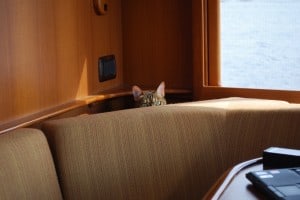
On the other hand, we can step into the pilot house and find ZuZu in a pose like this – don’t know if she’s scared of something, or if this is her way of keeping a quiet eye on things. Kap had taken an upper cushion from the settee corner, and ZuZu’s down behind the cushion.
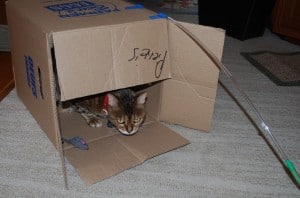
. . . and I really like having a good cardboard box to play in when I get tired of snoozing. It just doesn’t get any better for a cat.
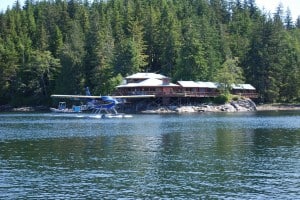
The Kenmore Air Turbo-Otter – painted in King-5 TV Evening Magazine livery – landed right in front of our bow one morning, then taxied over to the Farewell Harbour Resort dock to drop off a passenger. It wasn’t there more than one minute, then taxied by us and powered up about 50’ off our port side.
Kenmore Air float planes flew in twice while we were here – the first time a Beaver that landed out in the middle of the harbor and dropped off a passenger directly into a dinghy that came alongside from another cruiser anchored here in the harbor. This is the wonderful thing about Kenmore Air – they will fly in anywhere to drop off or pick up passengers – private docks, any resort in Desolation Sound or the Broughton’s, or even right next to your boat.
We’re anchored about 500’ off shore from a fancy-schmancy fishing lodge called the Farewell Harbour Resort. It caters to fishing groups, with about 8 luxury cabins, a lodge building with a nice restaurant, and probably crew quarters. We’ve anchored in here twice now in the past several years, but have never seen anyone at the resort, and with binoculars we could see that the bed mattress in each guest cabin was leaned against the wall, and no sign of life whatsoever around the lodge restaurant. We figure the GFC has pretty much wiped out several summers for this type of operation in many places.
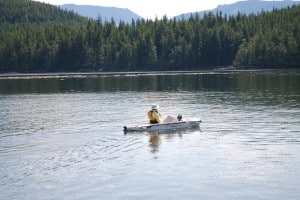
Kap loves to explore every bay and lagoon with her Hobie pedal kayak, and often takes Gator with her – but this time he isn’t on board, so she went alone. I like it too, but prefer the temperature to be a bit warmer.
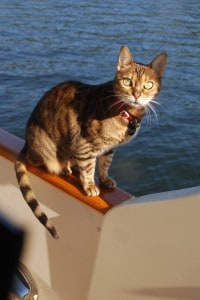
While Kap was away in the kayak, I looked out the galley window to see if I could see her - and spotted ZuZu sitting contentedly on a 4” wide section of railing. She’s fascinated with the water and loves to sit and look at it. She also loves to sit on anything high up, and preferably narrow - just because she can.
After a couple of days at Farewell Harbour, it became obvious that it wasn’t going to be quiet and secluded as we thought it would be. By this morning there were 12 other boats at anchor here with us and we felt like we were in an RV park. Some of was comical – watching other people’s techniques at raising and lowering their anchors is a real spectator sport – so much so that Kap proposed we bring along a video camera and film some of them, then edit them, and sit around sometime with friends to watch them and vote on which is the more entertaining. (And yes, I’m well aware that our prop bashing of A-oh and wrapping our prop shaft with A-oh’s line would fall in that same category!)
One sailboat came in at an incredible fast speed, didn’t cruise around at all to find the best available spot, and instead dropped anchor while still underway. When the anchor dragged on the bottom, the chain almost took out the bow of his boat. He then backed down on it, dragging the anchor without putting out more chain, and the sailboat quickly lurched to a stop when the anchor set. Going forward again at high speed, he then raised his anchor and almost struck his bow with the anchor when it rose through the surface. He was so close to us we were worried he had dropped his chain over ours, and then he would have brought up our anchor – and that wouldn’t have been good for us. Luckily, he didn’t, and to our relief he then moved off to another spot far away from us.
Another guy in a 60’ Tollycraft, homeported in Bel Air, CA (next to Beverly Hills and Hollywood) is anchored behind us about 500’. Several times a day he roars in and out in his towed 20’ aluminum fishing boat, setting up a wake that rocks us from side to side. This morning he raced by a group of kayakers paddling through the harbor, and we could hear them yelling at him to slow down and not swamp them with his wake. When he returned, we’d had enough of it and we too hollered over to him to slow down. Without doing so, he yelled over that he had some free crab – we told him what he could do with his free crab.
Oh well, that’s the price to be paid for cruising in one of the most scenic places in the world – everyone else wants to as well. It’s gotten so bad in just the short five years that we’ve been cruising here we’ve talked about skipping the Broughton’s in future years and continue further north. There will always be jerks wherever one goes, but with fewer total cruisers, the odds are there will be correspondingly fewer jerks.
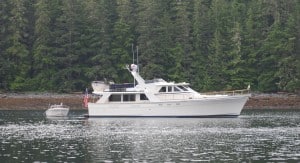
One boat we always like to see arrive when we're at anchor or moored is the MARY E, a 61' Tollycraft (American-built). She's owned by Tom and Mary Gallagher, who live in Tacoma and belong to the Seattle Yacht Club. They've been very helplful to us in learning to prawn, and they're just plain nice people. We think the Tollycarft (and the Fleming, of course) are what a cruising boat should look like.

